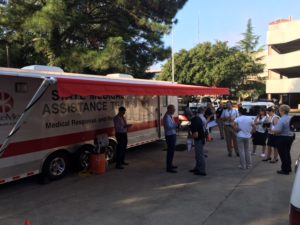This report highlights the actions taken, lessons learned, observations and hospital experiences that occurred after the Las Vegas mass shooting.
Category: NCTC
CapRAC Newsletter – October Issue Released
The October issue of the CapRAC Newsletter is now available. Access the full issue: October 2018 Newsletter
CapRAC Supports Launch of WakeMed Drone Program

The CapRAC Healthcare Preparedness Coalition deployed its Medical Support Unit (MSU) Trailer with generator to serve as a mobile command center, a radio package and several cooling/misting fans to help combat the 90+ degree temperatures for the launch of the WakeMed drone program.
WakeMed teamed up with the NC Department of Transportation’s Division of Aviation and Swiss company Matternet to launch the first medical drone delivery in the U.S. under the Federal Aviation Administration’s Integration Pilot Program. Test drone flights were held at WakeMed Raleigh Campus August 29 through August 31. These initial test drone flights will carry simulated medical packages from Raleigh Medical Park on Sunnybrook Road, up and over the Andrews Center and to a drop-off location at Raleigh Campus.
Developing healthcare-related uses for drones will improve speed of deliveries, enhance access to care and create healthier communities. In the next two years, WakeMed hopes to move medical material by drone to other facilities in a 12-mile radius.
ASPR TRACIE Newsletter – Issue 7 Released
The latest issue of The Exchange newsletter is now available. The articles in this issue of The Exchange highlight the healthcare response to no-notice incidents (in this case, mass shootings) and discuss some of the challenges associated with providing care during those incidents. For more information, please view the full newsletter at the link below.
aspr-tracie-the-exchange-newsletter-issue-7-508
ASPR TRACIE: No-Notice Incident Tip Sheets
ASPR TRACIE has developed mass violence resources to help stakeholders prepare for, respond to, and help their communities recover from no-notice traumatic events. Topics include Hospital Triage, Intake and Throughput, Family Assistance and Fatality Management, to name a few.
To access these tip sheets and other information, please visit ASPR TRACIE
HPP 15th ANNIVERSARY
The Healthcare Preparedness Program (HPP) celebrates 15 years of preparedness and response!
To read more about the history and accomplishments of the program, please visit: HPP-15-anniversary
ASPR TRACIE: New Resources Added
ASPR TRACIE recently added several new resources to its site. Newly added information includes considerations for managing seasonal surge, pediatric issues in disasters, upcoming webinars on emerging infectious disease preparedness and health care response to no-notice events.
For more information on these and other topics, please visit ASPR TRACIE.
CMS EM Final Rule: organizations required to have two emergency operations plan exercises
CMS EXERCISE UPDATE
The Joint Commission confirmed with the Centers for Medicare and Medicaid Services (CMS) that organizations are required to have two exercises of their emergency operations plan annually (responses to actual disasters can serve in lieu of planned exercises). This is required as part of the standards that became effective on Nov. 15, 2017, in response to CMS’ Emergency Management Final Rule.
Leave this site and read the entire Joint Commission article here.
Hospitals, Others Share Evacuation Lessons from 2017 Hurricanes, Wildfires
Hospitals, Others Share Evacuation Lessons
The latest newsletter from the Department of Health and Human Services’ Office of the Assistant Secretary for Preparedness and Response highlights evacuation stories from last year’s hurricanes and wildfires. Among other stories, Kaiser Permanente officials share their personal and professional experiences evacuating a hospital in the midst of the California wildfires, and a Baptist Beaumont (TX) Hospital official shares how staff worked tirelessly to care for patients during Hurricane Harvey.
Leave this site and access the full ASPR TRACIE newsletter
Flu Surge Questions grow
Influenza-like illness (ILI) surge and options for surge management. The program office for the State Hospital Preparedness Program has shared the following regarding influenza-like illness (ILI) surge and options for surge management:
Any requests for approval of bed increase or alternation, temporary facilities including soft structures, or other alterations to operations will need to be routed through the appropriate regulatory section at DHSR. Before we can clear any of these alterations that are utilizing SMRS equipment, the DHSR section will need to have approved. A couple of reminders: per CMS, billing cannot be completed in soft structures and you cannot move patients from a hard to soft structure.
Second, the Acute Care Section shared the regulation on alteration of bed capacity that is listed below for reference.
Finally, 1135 waivers require both the US HHS Secretary to declare a public health emergency and a Presidential declaration under the National Emergencies Act or Stafford Act. More information on current waivers can be found here.
10A NCAC 13B .3111 TEMPORARY CHANGE IN BED CAPACITY
(a) A hospital may temporarily increase its bed capacity by up to 10 percent over its licensed bed capacity, as determined by the administrator, by utilizing observational beds for inpatients for a period of no more than 60 consecutive days following approval by the Division of Health Service Regulation.
(b) To qualify for a temporary change in licensed capacity, the hospital census shall be at least 90 percent of its licensed bed capacity, excluding beds that are under renovation or construction, and the hospital must demonstrate conditions requiring the temporary increase that may include but are not limited to the following:
(1) natural disaster;
(2) catastrophic event; or
(3) disease epidemic.
(c) The Division may approve a temporary increase in licensed beds only if:
(1) It is determined that the request has met the requirements of Paragraphs (a) and (b) of this Rule; and
(2) The hospital administrator certifies that the physical facilities to be used are adequate to safeguard the health and safety of patients. However this approval shall be revoked if the Division determines, as a result of a physical site visit, that these safeguards are not adequate to safeguard the health and safety of patients.
History Note: Authority G.S. 131E-79;
Eff. April 1, 2003;
Pursuant to G.S. 150B-21.3A, rule is necessary without substantive public interest Eff. July 22, 2017.
